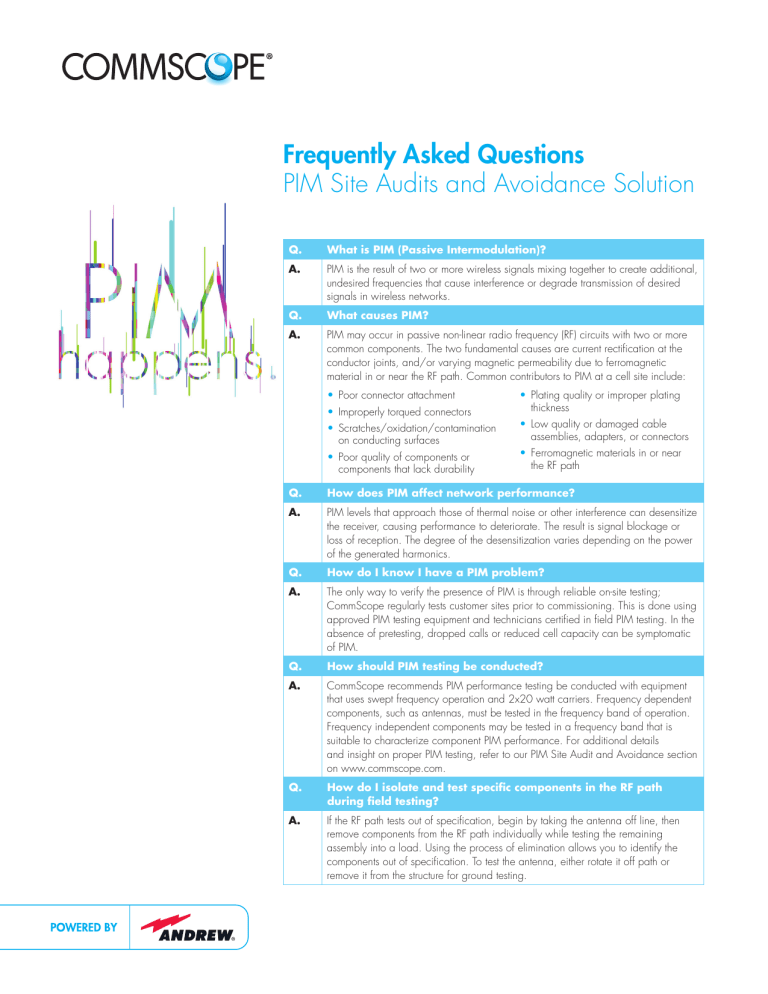PIM Happens Frequently Asked Questions

Frequently Asked Questions
PIM Site Audits and Avoidance Solution
Q.
A.
Q.
A.
Q.
A.
Q.
A.
Q.
A.
Q.
A.
What is PIM (Passive Intermodulation)?
PIM is the result of two or more wireless signals mixing together to create additional, undesired frequencies that cause interference or degrade transmission of desired signals in wireless networks.
What causes PIM?
PIM may occur in passive non-linear radio frequency (RF) circuits with two or more common components. The two fundamental causes are current rectification at the conductor joints, and/or varying magnetic permeability due to ferromagnetic material in or near the RF path. Common contributors to PIM at a cell site include:
• Poor connector attachment
• Improperly torqued connectors
• Scratches/oxidation/contamination on conducting surfaces
• Poor quality of components or components that lack durability
•
•
•
Plating quality or improper plating thickness
Low quality or damaged cable assemblies, adapters, or connectors
Ferromagnetic materials in or near the RF path
How does PIM affect network performance?
PIM levels that approach those of thermal noise or other interference can desensitize the receiver, causing performance to deteriorate. The result is signal blockage or loss of reception. The degree of the desensitization varies depending on the power of the generated harmonics.
How do I know I have a PIM problem?
The only way to verify the presence of PIM is through reliable on-site testing;
CommScope regularly tests customer sites prior to commissioning. This is done using approved PIM testing equipment and technicians certified in field PIM testing. In the absence of pretesting, dropped calls or reduced cell capacity can be symptomatic of PIM.
How should PIM testing be conducted?
CommScope recommends PIM performance testing be conducted with equipment that uses swept frequency operation and 2x20 watt carriers. Frequency dependent components, such as antennas, must be tested in the frequency band of operation.
Frequency independent components may be tested in a frequency band that is suitable to characterize component PIM performance. For additional details and insight on proper PIM testing, refer to our PIM Site Audit and Avoidance section on www.commscope.com.
How do I isolate and test specific components in the RF path during field testing?
If the RF path tests out of specification, begin by taking the antenna off line, then remove components from the RF path individually while testing the remaining assembly into a load. Using the process of elimination allows you to identify the components out of specification. To test the antenna, either rotate it off path or remove it from the structure for ground testing.
Q.
A.
Q.
A.
Q.
A.
Q.
A.
Q.
A.
Q.
A.
Q.
A.
What is CommScope’s recommended system level
PIM specification?
Recommended PIM levels are largely dependent on the specifications of the system being tested. We suggest using CommScope’s online PIM and VSWR System
Calculator. It enables you to input the basic characteristics of your system then provides an estimate of the acceptable PIM levels for the RF path being tested. You can access this tool in the Resources section or by visiting our PIM Site Audit and
Avoidance webpage section on www.commscope.com.
How does CommScope limit the impact of downtime while field testing for PIM?
Additionally, by working with you to test frequencies within your operating band and reducing transmit power when possible, we can mitigate some of the inconveniences associated with field testing for PIM.
How does CommScope minimize the impact on other carriers’ availability during system testing?
CommScope works to minimize unwanted RF radiation during testing. For instance, we test antennas at ground level and test transmission lines as well as other components into a load. We prefer to conduct testing during the evening maintenance window and will work with customers to test frequencies within their operating band if possible.
What documentation does CommScope provide as part of a standard PIM test?
The PIM testing equipment we use automatically generates a comprehensive report saved as a PDF file. The report includes site specific information that includes sector and line description, TX frequencies and their power output levels, 3rd order mode frequency readings, a pass/fail threshold value, time and date stamps, and operator information.
Does CommScope perform site testing?
CommScope’s Wireless Turnkey Deployment services can perform PIM testing.
The cost for PIM testing varies based on location, the number of lines being tested, and the overall scope of work. Please contact our technical support services at
1-800-255-1479 for assistance with your requirements.
How do I check the PIM specification on the individual
CommScope RF components I’ve purchased?
The product specifications for our passive products list the PIM specification for each individual product. To access the specifications, go to www.commscope.com and click the Product Catalog tab. Enter the name or part number of the component. All
PIM testing on Andrew’s RF components is conducted utilizing 2x20 watt carriers and in the swept frequency mode.
Is there a PIM calculator?
Yes. CommScope has developed several PIM calculators to support your RF path analysis.
1. PIM and VSWR System Calculator (Global)
2. Band and Block Second and Third Order PIM Calculator (North America)
3. Band and Block Second and Third Order PIM Calculator (EMEA)
For more details or to download the calculators, please visit the “Resources” section located on www.commscope.com.
2
Q.
A.
Q.
A.
Q.
A.
Q.
A.
Q.
A.
Q.
A.
Q.
A.
Q.
A.
Are there any performance guarantees that address PIM levels across my system?
Yes, CommScope is able to provide a complete RF Path Warranty, guaranteeing
PIM performance across the system. Contact your sales rep for more information about how your system qualifies.
Are all CommScope products individually PIM qualified and factory tested?
Many products are 100% tested for PIM. For specific information on your product please go to www.commscope.com and utilize the Product Catalog section to obtain PIM specification. For specific questions we encourage you to contact CommScope’s Technical Support by phone (800-255-1479) or email
(acicustomersupportcenter@commscope.com).
Does CommScope provide supporting data for factory-tested products?
Yes, CommScope offers support data through WebTrak, our online certified report system. It’s a quick and easy online tool that lets you access performance testing results for CommScope solutions. We also provide the convenience and quality of
WebTrak on your iPhone ® or iPad ® through our new cTrak app available on iTunes.
Visit our “Resources” section on www.commscope.com for more info.
What PIM testing equipment do you recommend?
PIM should always be done with 2x20 watt carriers and preferably with PIM equipment that can support swept frequency mode testing.
Does CommScope provide PIM and VSWR training?
Yes, the CommScope Infrastructure Academy, has developed a new PIM and
VSWR training and certification class available on-line. Here, network installers will learn the proper techniques for testing, measuring and mitigating PIM for wireless infrastructures. Visit our PIM Site Audit and Avoidance page on www.commscope.com.
How long does it take to test a system?
The time required to adequately test for PIM depends upon the number of antennas and transmission lines in the site or sector, as well as the scope of work. To test a system and provide the necessary reports may be done in as little as several hours or may take as long as a few days.
Note: While PIM testing can often be done in less than a day, isolating the cause of PIM and correcting it may take several days, underscoring the importance of pretesting and prevention.
Is there a preventative maintenance schedule for PIM?
When upgrades or changes are made to the RF path, PIM levels should be checked. Additionally technicians should receive regular installation and connectorization training, such as that offered by the CommScope Infrastructure
Academy, which teaches PIM prevention techniques.
How often does CommScope recommend checking for PIM?
Since the RF path must be off line during PIM testing, CommScope suggests testing yearly or when the site or sector performance suggests a problem.
3
Q.
A.
Where can I find additional information and resources on
PIM and PIM testing?
We recommend starting your research at the PIM Site Audit and Avoidance section on www.commscope.com. Here, you’ll find a range of educational materials that goes beyond the web. At the CommScope Infrastructure Academy, our internationally recognized distance education program, we’ve developed a new
PIM and VSWR curriculum that helps your installers and field technicians minimize
PIM during installation.
Through CommScope’s Technical Support Center, we offer 24/7 technical support for all PIM-related issues, with a dedicated team of technical experts experienced in troubleshooting, diagnosing, and resolving PIM issues.
They are available via toll-free phone (800-255-1479) or email
(acicustomersupportcenter@commscope.com).
For more information, contact CommScope Technical Support v800-255-1479 or
(acicustomersupportcenter@commscope.com)
www.commscope.com
Visit our website or contact your local CommScope representative for more information.
© 2013 CommScope, Inc. All rights reserved.
All trademarks identified by ® or ™ are registered trademarks or trademarks, respectively, of CommScope, Inc.
This document is for planning purposes only and is not intended to modify or supplement any specifications or warranties relating to CommScope products or services.
CO-104463.3-EN (11/13)
4


